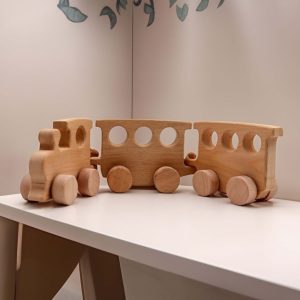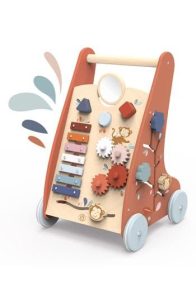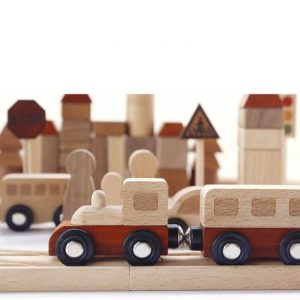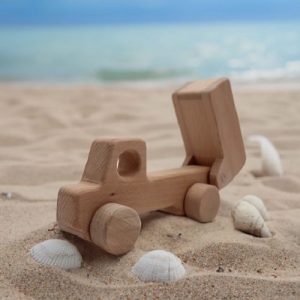The world of store-bought toys can be overwhelming. But what if you could create something unique and special with your own hands? Wooden toys offer a timeless charm and endless possibilities for customization. In this comprehensive guide, we’ll delve into the wonderful world of wooden toys, from essential tools and materials to make wood toy for all skill levels.
Gather Your Tools and Materials
Before diving in, it’s important to assemble your wood toy-making arsenal. Here’s a basic list to get you started:
- Wood: Opt for softwoods like pine or basswood for ease of cutting and shaping. Hardwood like maple or oak is great for sturdier toys once you gain experience.
- Safety Gear: Safety glasses and a dust mask are a must to protect yourself from sawdust and flying debris.
- Saw: A coping saw offers good control for precise cuts. A jigsaw provides more versatility for intricate shapes.
- Sandpaper: Various grits (coarse to fine) are needed for smoothing rough edges and achieving a polished finish.
- Drill and drill bits: Useful for creating holes, attaching components, and adding details.
- Hammer and nails: Perfect for assembling various wooden parts.
- Wood glue: Ideal for creating strong bonds between wooden pieces.
- Pencil and ruler: For marking measurements and designing your toy.
- Optional: Depending on your project, you might also consider using a wood rasp, carving knife, or decorative paints (non-toxic and child-safe).
Choosing Your Perfect Project
The beauty of wooden toys lies in its limitless possibilities. Here are a few project ideas categorized by skill level:
Beginner-Friendly:
- Pull toys: Simple designs like a car or a boat with wheels and a string are perfect for getting started.
- Nesting dolls: Craft a set of progressively smaller dolls that stack inside each other.
- Wooden puzzles: Create chunky puzzles with basic shapes like squares, circles, and triangles.
Intermediate Level:
- Animals: Whittle out a charming collection of farm animals or woodland creatures.
- Dolls and dollhouses: Build a simple dollhouse structure and design furniture pieces.
- Building blocks: Craft a set of wooden blocks in various shapes and sizes for open-ended play.
Advanced:
- Vehicles: Take on a more challenging project by building a car, truck, or airplane with moving parts.
- Marble maze: Design a multi-level maze with ramps and obstacles for marbles to navigate.
- Musical instruments: Create simple instruments like a shaker or a drum for toddlers to explore sound.
Remember: These are just a springboard for inspiration. Feel free to adapt these ideas or design your own unique toys!
Let’s Get Crafting!
Now that you have your tools, materials, and a project in mind, it’s time to make wood toy! Here’s a general workflow to follow:
- Sketch and Design: Draft a basic plan or sketch of your toy. This helps visualize the final product and identify any potential challenges.
- Cut the Wood: Use your saw to cut the necessary wooden pieces based on your design and measurements. Sand down any rough edges for safety and aesthetics.
- Shape and Assemble: For more detailed features, you can use a wood rasp or carving knife to refine the shapes. Use wood glue and nails or screws to assemble the different wooden parts.
- Finishing Touches: Once assembled, sand the entire toy for a smooth finish. You can add decorative touches with non-toxic paints or leave the natural wood grain exposed for a classic look.
Safety First!
Working with wood requires prioritizing safety. Here are some important reminders:
- Always wear safety glasses and a dust mask when using saws and sanders.
- Keep sharp tools out of reach of children.
- Ensure proper ventilation in your workspace to avoid inhaling sawdust.
- Use non-toxic and child-safe paints and finishes on your wooden toys.
Crafting wooden toys offers a rewarding and enriching experience. It fosters creativity, resourcefulness, and a sense of accomplishment. More importantly, you’ll be creating something special and unique that can spark a child’s imagination and provide countless hours of enjoyment. So, grab your tools, unleash your inner carpenter, and embark on the wonderful journey of making your own wooden toys!

Adding Your Personal Touch
Once you’ve mastered the basics of creating wooden toys, you can incorporate your own artistic flair to make them truly special. Here are some ideas:
- Paint It Up: Paint your creations in bright colors or fun patterns. Let your imagination run wild and create a masterpiece!
- Playful Details: Add details like googly eyes, yarn hair, or fabric scraps for clothing to bring your wooden characters to life.
- Engraving: If you’re comfortable using woodworking tools, you can try woodburning or carving initials, names, or even a short message onto your toy.
Sharing the Joy
Homemade wooden toys make fantastic gifts for children. They are not only unique and personal, but also crafted with love and care.
Here are some ideas for sharing your wooden creations:
- Gift It: Present your handcrafted toy to a special child for their birthday or another occasion.
- Get Creative Together: Host a craft session with your kids and guide them in decorating unfinished wooden toys (purchased from craft stores) or simple wooden shapes you’ve cut out yourself.
- Donate It: Donate your wooden toys to local shelters, orphanages, or children’s hospitals to bring joy to kids in need.
Remember, the most important aspect of crafting wooden toys is the process itself. Embrace the joy of creation, unleash your creativity, and have fun along the way!

Safety Tips for Advanced Techniques
As you delve into more advanced woodworking techniques, here are some additional safety tips to make wood toy:
- Dowel Joints: When using dowel rods, ensure they fit snugly but not overly tight in the pre-drilled holes to avoid splitting the wood.
- Sharp Tools: Sharpen your tools regularly to ensure clean cuts and reduce the risk of slipping.
- Power Tools: If you’re using power tools like a drill or a small craft benchtop sander, ensure you are familiar with their safe operation and always follow the manufacturer’s instructions.
Remember, with practice and these helpful tips, you’ll be well on your way to crafting exceptional wooden toys that are both fun and safe for children to enjoy.



